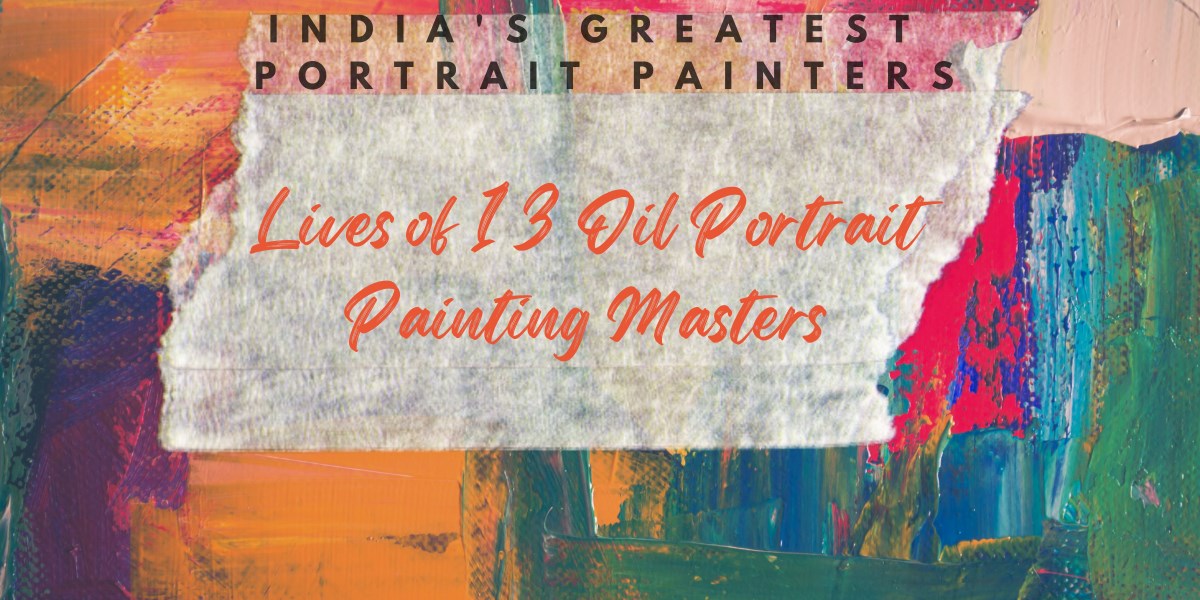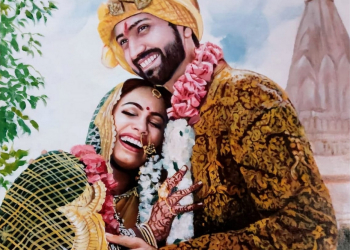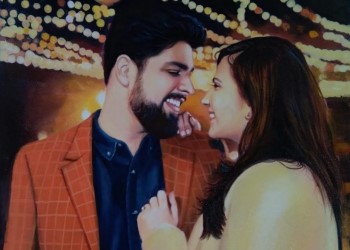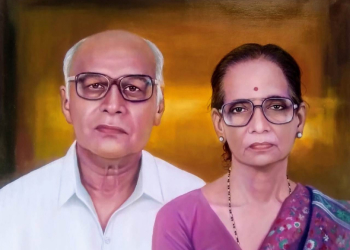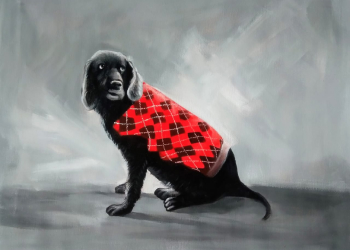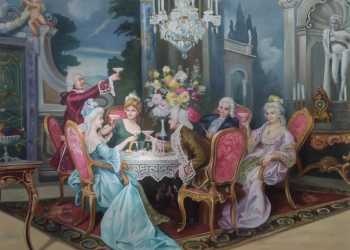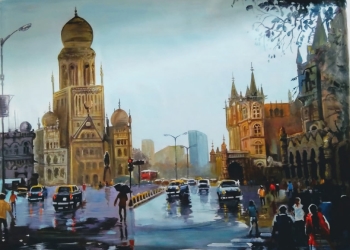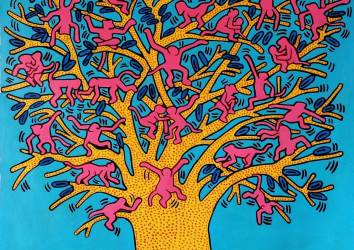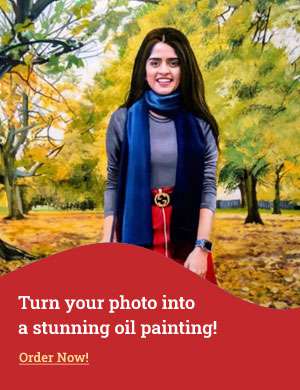The wild success of Raja Ravi Varma’s portraiture and paintings, and the establishment of art schools and institutions inspired a whole crop of new artists to step into the art world. We profile 13 of the very best portrait painters and artists that India ever produced. The post came over 8000 words long so we broke it into two parts. Posted here is Part 1 of the series. You can read Part 2.
Introduction: A short history of Art in India
The history of Indian art is remarkably long and impressive. As the sub-continent underwent various political changes over the centuries, art also experienced tensions, ruptures, and evolutions.
The history of oil portrait painting is very old in India. Oil painting itself was invented in India, long before it reached the Westen world through Europe. Artists of India practiced the art of portrait painting for approximately 1000 years before it reached the Flemish painters in Europe.
The style of art of the Indian artists underwent many changes during the Mughal period, as we wrote in Brief History of Paintings, with the synthesis of Persian influences and during the colonization period of India when Kampani paintings came into vogue. The capabilities of Indian painters can be appreciated from the miniature illustrations of Akbarnama and Baburnama, which were commissioned to record the visual history of the Mughal kings. The books show illustrations of Mughal kings performing their kingly duties like holding court, hunting, and spending leisure time. But due to economic decline, invasions, and stagnation, the art of portrait painting became a neglected art.
Impact of Colonization and the Invention of the Photography on Indian Portrait Painting Artists
Due to the arrival of European colonizers, the invention of the camera, and the formal art schools' method of teaching painters in India, European academic realism was brought to Indian portraiture.
Before the invention of the camera, a portrait would require the subject to sit still for hours and days to have their portrait made. With the invention of photography, the art of portraiture became more approachable and accessible.
Once a photograph was taken of the intended subject, the artist would then use it as a reference to complete the painting. This not only made the work easier for the artist and subject alike by eliminating the need to sit still for extended periods, but it also served to boost the popularity of portraiture as an art form. Later, an entire art movement grew from this style of painting called Photorealism
The Popularity of Portraitures as Gifts
Another factor that contributed to the rise in popularity of portrait paintings, was the “Gift” culture introduced by the British colonizers. General Hastings dispatched British portraitists to indigenous courts to capture the likenesses of Indian rulers. These symbolic portraits were then presented to Company authorities as gifts, replacing the traditional Mughal offerings of robes or nazr (tribute money). The intent was to substitute the previous gifts of land grants, jewels, and money, sometimes used as bribes, with a more symbolic and deeply personal form of a gift: painted portraits. Princely rulers also sought to mimic the British by incorporating British art into their collections. Portraits, therefore, played a key role in strengthening kinship networks since they helped evoke the presence of the absent donors, which helped foster diplomatic harmony.
Even now portrait paintings continue to be popular in the gifting culture. People use portrait paintings as gifts for important events such as wedding gifts, engagements gifts, anniversary gifts, Housewarming gifts, bereavement gifts, birthday gifts, and corporate gifts.
Order Your Portrait Painting from Photo today!
Impact of Raja Ravi Varma on Indian Portrait Artists
However, for all the developments in the artistic field of portrait painting, most of the recognition and the gains accrued were to small-time European artists and painters, as Indian princely states mimicked the European colonizers, preferring European painters compared to Indian “native” artists. It was not until Raja Ravi Varma the art of portrait painting revived again. Raja Ravi Varma was a prolific mythological as well as a portrait painter. As a forerunner of modernity, he stood for the fusion of the old and the modern, resulting in the creation of an entirely new genre of mythological oil painting. According to author Shalvi Agarwal, “Ravi Varma stood as the only artist to receive an imperial accolade as well as the painter who helped in nation-building. He enjoyed a popularity transcending ethnicity, class, culture, and region that has not been equaled since.”
The popularity of Raja Ravi Varma’s work spawned a whole new generation of artists who were inspired by him and popularised portraiture. Portrait painting evolved into a highly organized enterprise, with theories and guidelines about the style published during the early part of the 1900s.
The success of "The Great Exhibition" in 1851, which opened in London with India participating, was one of the significant events that reshaped the landscape of the Indian art fraternity. According to the official catalog, India had the largest display space of any other Colony, Possession, or Dependency.
The art exhibition drew nearly 6 million visitors and reshaped the Western world’s opinion of Indian arts and artists. And laid the groundwork for the formation of art institutions in India.
Public perception of art changed as a result of art shows modeled on the European art exhibition style, and the rise of Indian journalism created a favorable public opinion of art awareness in Indian society.
The Times of India wrote in its paper about these artists that “unless these gentlemen’s names were there to testify to their pictures being the work of natives of India, they might have been taken for those of European painters. One seeks almost in vain for successors to those masters of miniature portraiture”.
A change in public perception and appreciation of art, the wild success of Raja Ravi Varma, and the establishment of art schools and institutions, led to a change in public opinion that art can be a viable career. A whole crop of new artists trained in Western academic art stepped into the art world.
In this post (part 1), we profile six of the 13 very best portrait painters and artists of India at that time. In part 2 we profile the balance of seven super-talented portrait artists. The list is arranged in a chronological manner in order of their births.
Order Your Custom Handmade Oil Portrait Painting from Photo today
13 Best Portrait Artists Of India of all time
Pestonji Bomanji
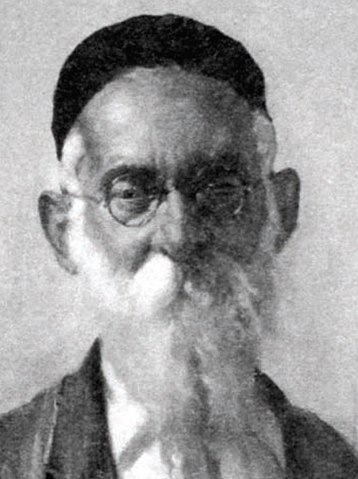 Pestonji Bomanji (1851-1938) (Image Credits: Wikipedia Commons)
Pestonji Bomanji (1851-1938) (Image Credits: Wikipedia Commons)
Pestonji Bomanji (1851-1938), a Parsi portrait painter and artist, made significant contributions to portrait painting at the Bombay art school. Recognized for his work at the Ajanta caves, Pestonji Bomanji shifted his focus to portraiture under the guidance of Valentine Prinsep. Bomanji became one of the first Indian teachers at the art school and won accolades at exhibitions, including being the first Indian to win a top prize in Calcutta (now Kolkata). Times of India described his portraits as “realistic and warty” and drew comparisons to Dutch realists, capturing Parsi customs and practices. His well-known work The Parsi Girl painted in 1887, was first shown at the Society.
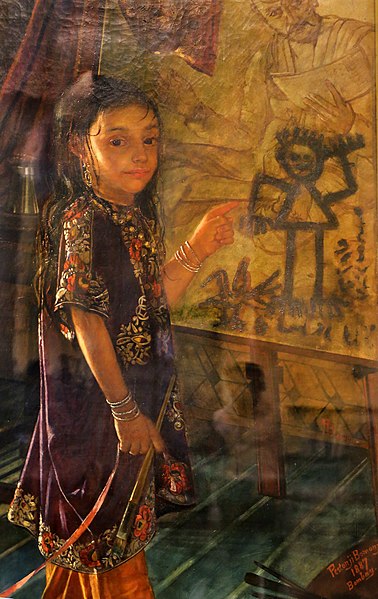 The Parsi Girl by Pestonji Bomani (Image Credits: Wikipedia Commons)
The Parsi Girl by Pestonji Bomani (Image Credits: Wikipedia Commons)
Title: The Parsi Girl
Creator: Pestonji Bomanji
Date Created: 1887
Medium: Oil portrait painting on canvas
Notably, Pestonji Bomanji’s portrayals of Parsi women reflected their early participation in public life compared to other communities. Bomanji's art serves as an ethnographic study, offering insights into Parsi culture. His talent and dedication to exhibitions shaped his career, showcasing his skill and earning him recognition. Despite his brief encounter with sculpture, Bomanji excelled in portraiture, impacting the art scene. His work documents the lives of his contemporaries, emphasizing the progressive nature of Parsi women and their evolving role in society. Pestonji Bomanji's artistic legacy remains an important contribution to the portrayal of Parsi identity.
You can learn more about the life and works of Pestonji Bomanji in our previous post, Mumbai’s Parsi Portrait Painters
M. V. Dhurandhar
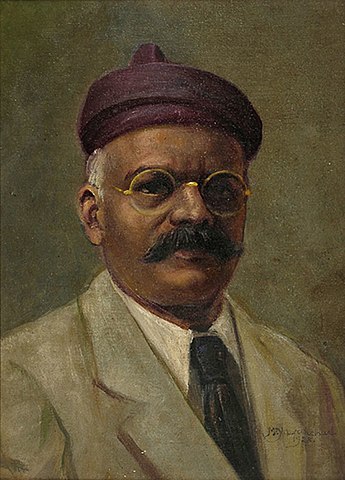 Self Portrait By M. V. Dhurandhar (Image Credits: Wikipedia Commons)
Self Portrait By M. V. Dhurandhar (Image Credits: Wikipedia Commons)
Mahadev Vishwanath Dhurandhar (1867-1944), was one of the first Maharashtrian artists and portrait painters to have gained critical acclaim and popularity as a portrait painter, artist, and art educator.
Hailing from Kolhapur, Maharashtra, he belonged to the Pathre Prabhu community, known for its artistic and literary talents. His encounter with European art in 1890 deeply impressed him, and he joined JJ School of Arts, determined to be an artist.
Dhurandhar described his thrilling encounter with Westen art on first seeing the antique statues in front of the art school. “ Standing in front of the huge plaster of Paris statues of the Venus de Medici, Apollo Belvedere, Apollo Saurochthonos, and the Discobolus, I felt as in a dream…I went round and round the statues and yet I was not sated…even out on the street, I felt like one possessed and kept seeing them appear before me.”
His dedication to his art impressed Griffiths at the art school as well as Principal Greenwood.
Unfortunately, his training at the art school was interrupted by the sudden death of his father. The school Principal not willing to lose a promising student like Dhurandhar, arranged for him to teach drawing at the local girls' school.
Dhurandhar made his debut at the Bombay Art Society in 1892 as a painting student. The drawing won him Rs. 50, the first of the many awards he won, and made his reputation in the region.
In 1896 when a position opened up in the art school Dhurandhar was given charge of the painting class. With his hard work and abilities, Dhurandhar rose to the position of Head Master, the highest position till then held by a “native” artist. His career continued on an upward trajectory, for the rest of his life. A testament to his talent and administrative acumen. 1918-31 Inspector of Drawing and Craft, J.J. School of Art, Bombay. Dhurandhar was the Vice-Principal for two years and then retired from the service. In 1927 he was awarded the title Rai Bahadur by the British rulers. Again he was reappointed as a visiting professor for a year. Officiated Director, J.J. School of Art, Bombay. In the year 1938, Dhurandhar was elected as the Fellow of the Royal Society of Arts.
Dhurandhar was a highly regarded painter in Western India, second only to Raja Ravi Varma in popularity. He was a gifted illustrator and skilled portrait painter with exceptional talent in figurative painting. His paintings range from portrait paintings, historical and mythological subjects to depictions of Hindu social life, customs, traditions, and festivals.
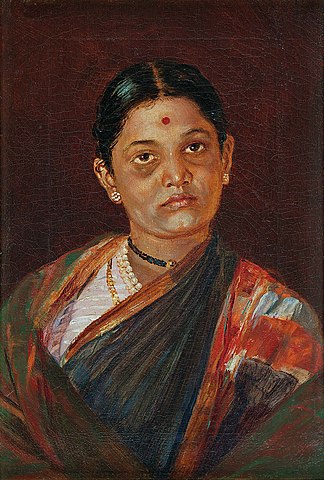 Oil Portrait Painting of the Artist's Wife by M.V Dhurandhar (Image Credits: Wikipedia Commons)
Oil Portrait Painting of the Artist's Wife by M.V Dhurandhar (Image Credits: Wikipedia Commons)
Title: Portrait of the Artist's Wife
Creator: M.V. Dhurandhar
Physical Dimensions: 11.5 inches x 8 inches ( 29.21 cm x 20.32cm)
Medium: Oil portrait painting on canvas
Location: National Gallery of Modern Art (NGMA), Mumbai, India
Handmade Art Reproductions & Landscape Paintings
He illustrated many books such as Women of India by Otho Rothfield, Deccan Nursery Tales, Tales of Vikramaditya by C.A. Kinkad, and By the Ways of Bombay by S.M. Edward. Dhurandhar also designed postcard art, which became very popular with Birtishers writing back to their families. He also did several ambitious murals for the New Delhi Secretariat.
Dhurandhar exhibited widely and won many awards and recognition for his works. Perhaps the most important one that bought early recognition was the Gold Medal awarded to him in 1895 by the Bombay Art Society for painting, “Have you come Lakshmi?”. Soon other Gold medals followed.
In 1904 he was awarded the Gold Medal, Industrial and Agricultural Exhibition., Bombay. In 1907 Gold Medal, Fine Arts, and Industrial Exhibition., Pandharpur. In 1910 Gold Medal, Art, and Industrial Exhibition, Jalgaon.In 1914 Gold Medal, Art, and Industrial Exhibition, Gwalior. And 1923 Prize in Wemble Exibhition., London
Dhurandar remained fascinated by figure painting and figure art throughout his life. Like other colonial artists of the time, Dhurandhar relied on pictures and photographs for honing his figure art skills, even after undraped art was introduced in the school. Dhurandhar never ceased to use photographs as the source material for his figure work and portraits.
Ghasiram Hardev Sharma
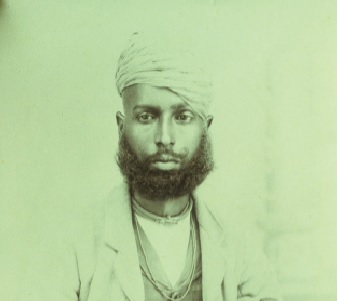 Ghasiram Hardev Sharma (1869-1931) (Image Credits: Tryna Lyons)
Ghasiram Hardev Sharma (1869-1931) (Image Credits: Tryna Lyons)
Ghasiram Hardev Sharma (1869-1931), born in the Nathadwara region of Rajasthan to Hardev Sharma, was a versatile and talented portrait painter and artist who straddled the realms of traditional temple art and the burgeoning art world of the 20th century. His artistic prowess extended beyond painting, as he was also an accomplished photographer who skillfully incorporated the aesthetic qualities of mechanically produced images into his portraits and narrative works.
While Ghasiram found fascination in European imagery and techniques and played a pivotal role in shaping a fresh popular Vaishnava art, his contemporaries held him in high esteem primarily for his innovative compositions, impeccable draftsmanship, and the elegance of his female figures. His skill as a portraitist was particularly evident in his numerous depictions of Tilakayat Govardhanlalji, offering us genuine glimpses into the life of a revered religious figure across different stages. Like Dhurandhar, Ghasiram was born into one of the hereditary artisan and creative communities.
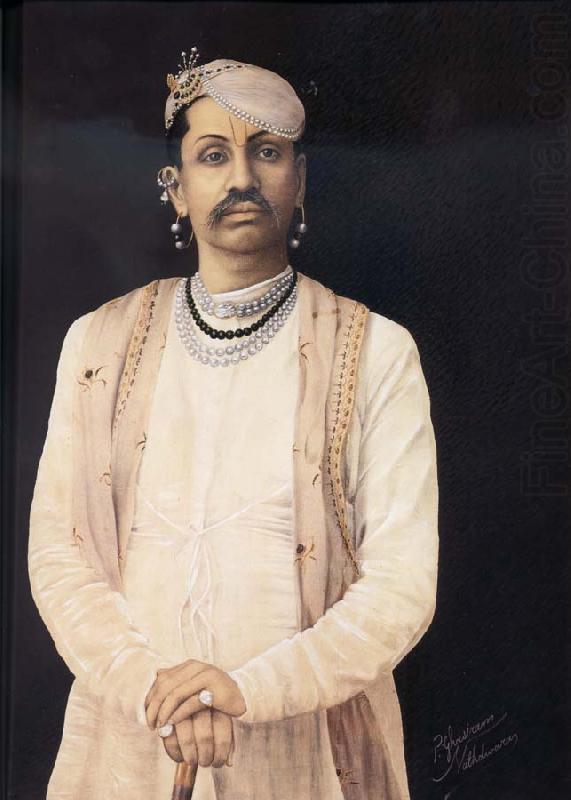 Tilakayat Govardhanlalji by Ghasiram (Image Credits: Asian Art Museum)
Tilakayat Govardhanlalji by Ghasiram (Image Credits: Asian Art Museum)
Title: Tilakayat Govardhanlal
Creator: Ghasiram Hardev Sharma
Date Created: 1915-1920
Physical Dimensions: 27.76 inches x 18.74 inches (62.9 cm x 47.6 cm)
Medium: Gouache on paper
Location: Asian Art Museum of San Francisco
The late 19th and early 20th centuries were a transformative period for young artists. Ghasiram, who likely received his initial art training from local artist Shalagram, further honed his skills under the tutelage of Mohanlal, the court painter, and photographer of Udaipur. In 1901, Ghasiram journeyed to Udaipur with fellow artisans from Nathadwara to pay homage to Raja Ravi Varma, the renowned painter from Kerala, during his visit to the Maharana's court. Additionally, Ghasiram is believed to have received guidance in European art methods and concerns from his brother-in-law Kundanlal, who had trained at London's Slade School. Although Kundanlal supposedly taught Ghasiram the esoteric technique of oil painting, the latter typically preferred the indigenous medium of gum-based gouache.
Ghasiram's extended leave from his position as the director of painting at the Nathadwara temple enabled him to assume the role of court artist for Maharaj Rana Bhavani Singh of Jhalawar. During a fruitful decade spanning approximately from 1912 to 1922, he contributed artwork to a progressive periodical published by the ruler of this small state in southeastern Rajasthan, while also overseeing extensive renovations in preparation for the Crown Prince's wedding in 1920.
Ghasiram's legacy in Nathadwara is one of artistic accomplishment and social advancement for traditional painters. Notably, he revolutionized the field by accepting apprentices from diverse communities. As the director of painting at the Shri Nathji temple, Ghasiram played a crucial role in connecting patrons with artists for commissions across the Indian subcontinent. Operating during a transitional period in Indian art, Ghasiram redefined Nathadwara's concept of feminine beauty by favoring a more subdued facial type and slender, graceful figures. A skilled portraitist, his portrayals of his patron Govardhanlalji were both insightful and compassionate. Colleagues and descendants alike assert that Ghasiram propelled the Nathadwara school into the modern age.
Antonio Xavier Trindade
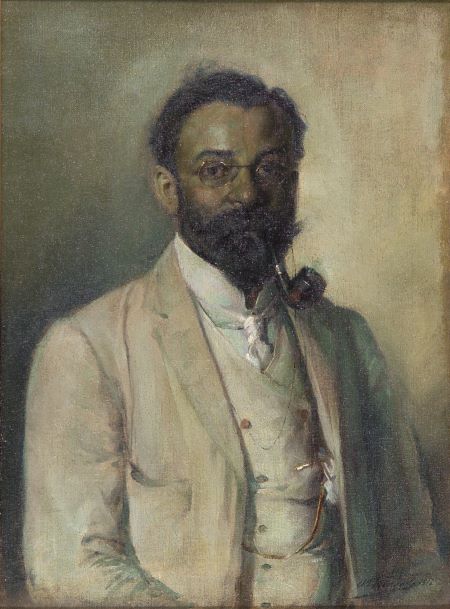 Self Portrait by Antonio Xavier Trindade (1870-1935) (Image credits: Fundação Oriente)
Self Portrait by Antonio Xavier Trindade (1870-1935) (Image credits: Fundação Oriente)
Antonio Xavier Trindade (1870-1935), born to Catholic parents in Goa, emerged as a prominent portrait painter and artist alongside renowned figures like Raja Ravi Varma and MV Dhurandhar during his time at the Sir Jamsetjee Jeejeebhoy School of Art. Antonio Trindade's exceptional powers of observation and compositional brilliance earned him the epithet "Rembrandt of the East" and garnered him the highest accolades an artist could aspire to during that era.
After the passing of his father, Antonio Trindade relocated to Bombay where he enrolled at the Sir Jamsetjee Jeejeebhoy School of Art. There, he honed his skills in European naturalism. In 1892, he received the prestigious Mayo Silver Medal in recognition of his artistic talent. Following his graduation, Antonio Trindade briefly joined the studio of Raja Deen Dayal, a renowned photographer of the time, where he assisted with tinting photographs. However, he soon moved on from this position as an opportunity arose at the art school. In 1898, Antonio Trindade commenced his career as a drawing and painting instructor at the Sir J. J. School of Art. Later, in 1914, he was appointed as the Superintendent of the Reay Workshop of Art at the same institution, a position he held until his retirement in 1926. Interestingly, M.V. Dhurandhar was also a contender for the same position at the art school, but Trindade ultimately secured it. Art historian Partha Mitter speculates that this may have been due to the British Raj's policy of encouraging Christians and individuals of mixed race, along with Principal Cecil Burns's apprehension towards Dhurandhar.
Antonio Xavier Trindade specialized in portrait painting, which supplemented his income from teaching. By 1920, his artistic style matured, primarily featuring portraits, landscapes, and still lifes. Influenced by his Western upbringing and the prevailing European artistic trends of the time, Antonio Trindade excelled in capturing intimate domestic scenes involving his wife and daughters. In his later years, he turned his focus to interiors, nudes, and landscapes.
The Bombay Art Society recognized Antonio Trindade's exceptional talent by awarding him its Gold medal, the highest artistic honor in India at the time, for his painting "Dolce Far Niente" (also known as "Flora" or "Mother Reclining"), which depicted his wife Florentina. In 1928, he received the inaugural Governor's Prize for his painting "New Year's Song," followed by another award two years later for "Hindu Girl."
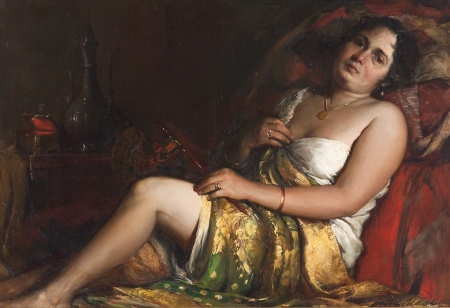 Dolce Farniente aka, Flora, Mother Reclining oil portrait by Antonio Xavier Trindade (Image Credits: Fundação Oriente)
Dolce Farniente aka, Flora, Mother Reclining oil portrait by Antonio Xavier Trindade (Image Credits: Fundação Oriente)
Title: Dolce Farniente aka Flora or Mother Reclining
Creator: Antonio Xavier Trindade
Date Created: 1920
Physical Dimensions: 39.76 inches x 54.72 inches ( 101 cm x 139 cm)
Medium: Oil portrait painting on canvas
Location: Fundação Oriente
Trindade's portraits not only demonstrated a profound understanding of his subjects' psychological profiles but also showcased his mastery of chiaroscuro. The vibrant palette he employed in his works reflected his engagement with late 19th-century color theories.
On March 16, 1935, Antonio Xavier Trindade passed away in his family home in Mahim, Bombay, leaving behind an extraordinary artistic legacy.
Manchershaw Pithawalla
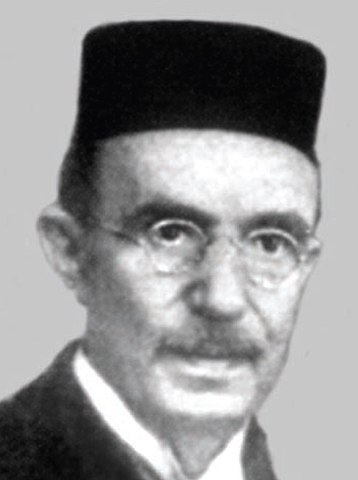 M.F. Pithawalla (1872-1937) (Image Credits: Wikipedia Commons)
M.F. Pithawalla (1872-1937) (Image Credits: Wikipedia Commons)
Manchershaw Pithawalla (1872-1937) was a talented portrait painter and artist from Pitha village in Surat, Gujarat. Discovered and trained by John Griffiths, the principal of the Sir Jamsetjee Jeejebhoy School of Art, Pithawalla won awards at the Bombay Art Society, becoming the only artist to win three consecutive prizes. His renowned painting "A Parsi Girl" also known as “A Girl Praying Near Fire” received high praise in Simla (1902), and he was invited to create an album celebrating Indian womanhood for Queen Mary's visit to India in 1905. Fulfilling his dream, Pithawalla traveled to Italy and held an exhibition in London's Doré Gallery in 1911, gaining recognition from the British press. The Graphic hailed it as the first exhibition by an Indian artist in London. Sir Mancherjee Bhownaggree, the second Indian elected to the British Parliament, hosted a reception in Pithawalla's honor. Pithawalla's artistic journey from a humble background to international recognition remains an inspiring story in the art world.
You can learn more about the life and works of Manchershaw Pithawalla in our previous post, Mumbai’s Parsi Portrait Painters
Jamini Prakash Ganguly
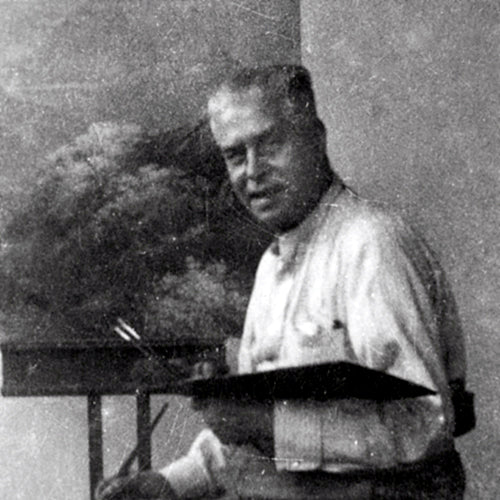 Jamini Prakash Ganguly (1876-1953) (Image Source: Internet Archives)
Jamini Prakash Ganguly (1876-1953) (Image Source: Internet Archives)
Jamini Prakash Ganguly (1876-1953), a nephew of Rabindranath Tagore and a member of the esteemed Tagore family, which also included Gagendranath and Abanindranath Tagore, played a significant role in the art scene of his time. During his formative years, Jamini Prakash studied under the British painter CL Palmer. Subsequently, he enrolled at the Calcutta Government Art School, where he came into contact with the eminent artist Pulin Kunda. Under Kunda's guidance, Jamini Prakash became proficient in the Western style of painting.
In 1916, when Abanindranath Tagore departed from the Calcutta Art School, Jamini Prakash was appointed as its Vice-Principal, assuming a position of influence within the institution. However, this led to a coolness between the Tagores and Ganguly. As Abanindranath Tagore was bypassed for the position of Principal in the school. Jamini Prakash Ganguly was later appointed Vice-Principal of the Sir J. J. School of Art in 1916, serving in that role until 1928. He was also responsible for dividing the Fine Art stream into two sections: Fine Art and Indian Painting.
Jamini Prakash Ganguly never became a part of the Bengal school panorama and was more interested in European stylistic values. An expert portrait painter and landscapist he was more drawn to European artistic ideals, and so he adopted the European school of visual expression. He became an expert in oil on canvas painting, and his talent was evident in a variety of genres, including neoclassical, mythical, and landscape painting.
Jamini Prakash excelled in the genres of portraiture and landscape painting, utilizing a distinctive color palette consisting of red, red ochre, and verdigris. For landscapes, he employed hues of yellowish tones, sky blue, crimson, and Prussian blue. Notably, he prepared his pigments for painting. In addition to portraits, he drew inspiration from religious themes found in Hindu epics such as the Mahabharata and the Ramayana, as well as landscapes. The majestic views of the Himalayas and the Kanchanjangha held a particular fascination for him, leading him to create numerous paintings capturing their essence. Furthermore, he depicted scenes featuring fishing boats and fleets of merchant vessels with billowing sails floating along river estuaries.
Noted for his landscapes and portraitures his works won several awards in the Indian exhibition circuit. Notably the 1910 Gold medal from the Bombay Arts Society, and the Finlay Prize in 1902 in Simla for his landscape Wet Banks of the Ganges. Covering his painting, the Pioneer said." Mr. J.P. Ganguly exhibits some very charming paintings of Bengal river scenery, either moonlight, misty morning or evening 'effects' They are very poetic in feeling and tender in color and treatment." In 1904 Jamini Prakash Ganguly exhibited his landscapes in Bombay (now Mumbai) and won the silver medal for oils.
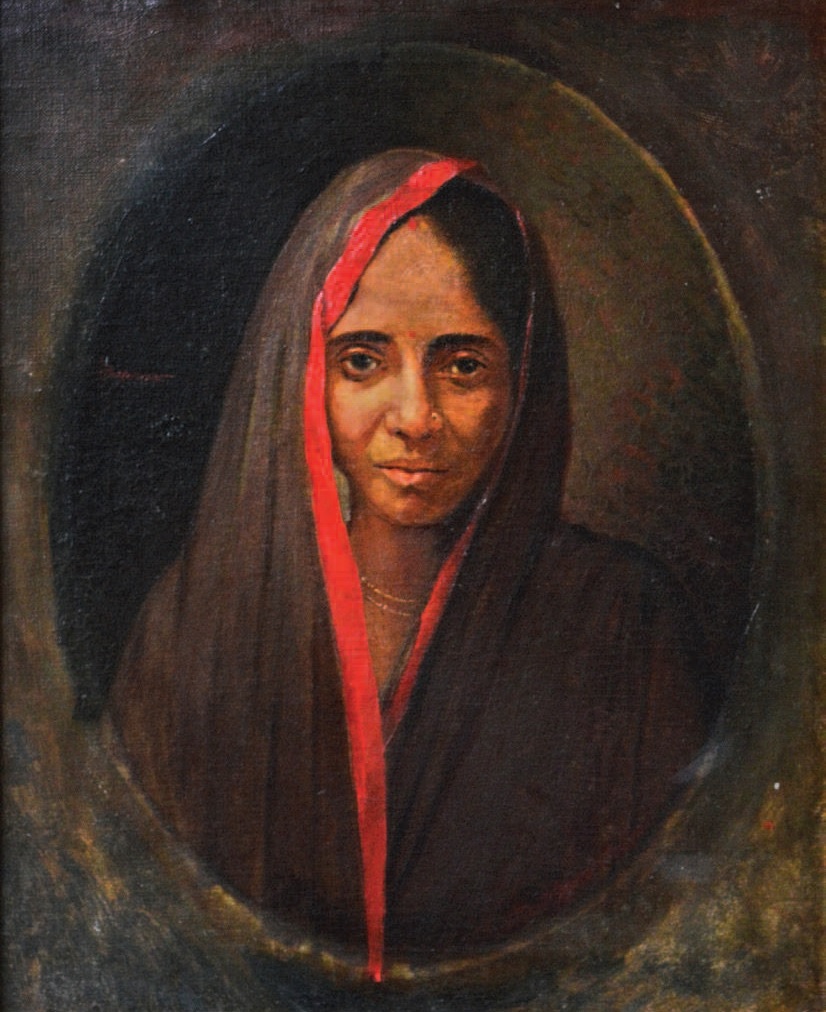 Oil Portrait Painting of a Lady by Jamini Prakash Ganguly (Image Credits: The Indian Portrait)
Oil Portrait Painting of a Lady by Jamini Prakash Ganguly (Image Credits: The Indian Portrait)
Title: Portrait of a Lady (Oil Portrait)
Creator: Jamini Prakash Ganguly
Date Created: 1930
Physical Dimensions: 22 inches x 18 inches ( 55.88 cm x 45.72 cm)
Medium: Oil portrait painting on canvas
Location: Private Collection
Among his notable works are 'Buddher Griha Tyag,' 'Shri Krishner Yugal Rupa (Kirshna through the ages),' 'Pujarini,' and 'Sandhya Aradhana.' Reproductions of some of his famous paintings, including 'Dinmojur,' 'Pujarini,' and 'Sandhya Aradhana,' were published in Sahitya and Prabasi, two renowned journals of his era.
Jamini Prakash Ganguly's artistic contributions were highly regarded during his lifetime and beyond. His mastery of portraiture and landscapes, coupled with his unique color choices, set him apart as a distinguished artist. His paintings not only captured the external beauty of his subjects but also conveyed their inner essence. With his rich artistic legacy, Jamini Prakash Ganguly remains a noteworthy figure in the realm of Indian art.
Conclusion
In Part 1 We explored the works and lives of six of the thirteen incredible portrait painters and artists who have left a permanent mark on the Indian art scene. Each artist has a unique style and approach, showcasing their individuality and artistic visions inspired by the iconic portrait artist Raja Ravi Varma, whose realistic depictions revolutionized Indian art. In Part 2 we profile the remaining seven artists.
About Us:
Paintphotographs.com is India's leading custom art platform. We turn your favorite photos, pics, and images into luxurious handmade portrait paintings. Our work includes handmade portraits, custom oil reproductions, charcoal drawings, and sketches. As a team of accomplished artists, we use museum-quality canvas, the best international brands of colors such as Winsor & Newton and Daler Rawney. We work with various mediums, including oil, acrylic, mixed media, graphite, and charcoal.
To order a custom handmade oil portrait painting you can visit our order now page. You can order custom Wedding Paintings, Couple Paintings, Memorial Paintings, Family Paintings, Baby portraits and Children Paintings, Photo to paintings, and Pet Portrait Paintings from Photo.
You can visit our pricing page to know the prices of our portrait paintings. To connect with us ping us on our chat messenger on the website, ping us on WhatsApp, call us at 918291070650, or drop us an email at support@paintphotographs.com
You can visit our gallery pages to see our work. We make photo to paintings, couple paintings, memorial paintings, Kids and Baby Portrait paintings, God & Religious Paintings, Old Photo to Paintings, Wedding couple Paintings & Marriage Portraits, Family Paintings, Pet Portrait Paintings, Radha Krishna Paintings, Oil Portraits of Gurus, Saints & Holy Men, Charcoal and Pencil Sketches, Custom Landscape & Cityscape paintings, Contemporary Art Reproduction & Replica Paintings, Old Master Reproduction & Replica Art, Monochrome and Black & White portrait paintings, Historical Portraits and Shivaji Maharaj Paintings, Celebrity & Political Leaders Portraits. We can also merge separate photos to create a single seamless painting called Composite portraits to add deceased loved ones to make a family oil portrait as though they were present.
Our custom handmade portraits make beautiful Anniversary Gifts, Engagement Gifts, Birthday Gifts, Retirement Gifts, Housewarming Gifts, Mother's Day gifts, and luxurious gifts for many important occasions.
Paintphotographs.com provides bespoke services for art patrons, interior designers, and architects. It helps you create the perfect pieces for residential and commercial projects and serves as a platform for artists to showcase their work.
If you are an art aficionado interested in writing a guest post on art, connect with us.
Want to read more? Check our reading recommendations below! Please refer to the Notes and Reference section for sources referenced in the article.
Like this story? Then you will love our podcasts on Spotify. Listen to our deep dives and fascinating stories from the art world. Join our nearly 20,000-strong community on Facebook, WhatsApp, and X.
Want to see our art? Join our community of 500,000+ subscribers on the Paintphotographs YouTube channel, Instagram, and Pinterest for some amazing art pics & art videos!
Recommended Pieces
A Brief History of Paintings, Portraits & Art! Development of painting movements | Paintphotographs
A brief history of oil painting technique | Paintphotographs
Ultimate 20 Best Oil Portrait Paintings of John Singer Sargent (Ranked) | Paintphotographs
Photorealism: The Art of making a painting from a photo. | Paintphotographs
The life and paintings of artist and painter KCS Paniker | Paintphotographs
Why is the Monalisa so famous? Monalisa's portrait painting history | Paintphotographs
Memorial Paintings - The Ultimate Guide to Commissioning one | Paintphotographs
Notes and reference section
https://www.google.co.in/books/edition/Art_and_Nationalism_in_Colonial_India_18/9mRTtkri8E0C
https://www.academia.edu/43976702/Ghasiram
Fundação Oriente Delegation in India, Panaji, India
https://greatbanyanart.com/collections/a-h-muller?sort=artist-a-z&tags=&p=1
J. A. Lalkaka | Making Britain
A moment captured in a masterpiece | Deccan Herald
Rustom Siodia: A Forgotten Master | Parsi Khabar
https://auctions.pundoles.com/lots/view/1-4TDNK/self-portrait
Rustom D. Siodia | Artist | Royal Academy of Arts
Bid & Hammer > M. F. PITHAWALA (1872 - 1937)
https://www.google.co.in/books/edition/The_Indian_Portrait_5/W06OBQAAQBAJ?hl=en
https://www.google.co.in/books/edition/The_Triumph_of_Modernism/krdWkzVLSbkC?hl=en

